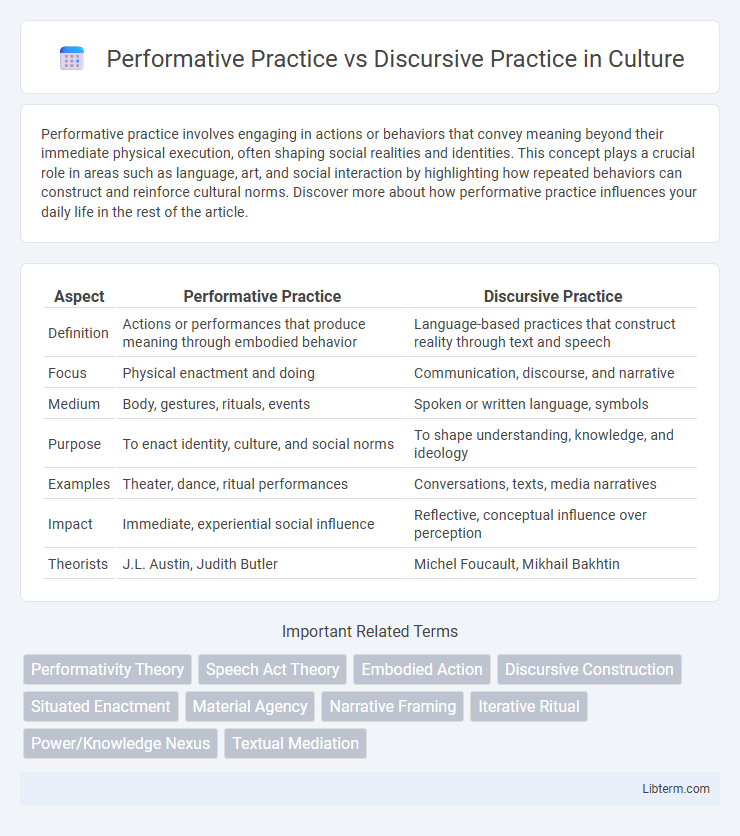Performative practice involves engaging in actions or behaviors that convey meaning beyond their immediate physical execution, often shaping social realities and identities. This concept plays a crucial role in areas such as language, art, and social interaction by highlighting how repeated behaviors can construct and reinforce cultural norms. Discover more about how performative practice influences your daily life in the rest of the article.
Table of Comparison
| Aspect | Performative Practice | Discursive Practice |
|---|---|---|
| Definition | Actions or performances that produce meaning through embodied behavior | Language-based practices that construct reality through text and speech |
| Focus | Physical enactment and doing | Communication, discourse, and narrative |
| Medium | Body, gestures, rituals, events | Spoken or written language, symbols |
| Purpose | To enact identity, culture, and social norms | To shape understanding, knowledge, and ideology |
| Examples | Theater, dance, ritual performances | Conversations, texts, media narratives |
| Impact | Immediate, experiential social influence | Reflective, conceptual influence over perception |
| Theorists | J.L. Austin, Judith Butler | Michel Foucault, Mikhail Bakhtin |
Understanding Performative Practice: A Clear Definition
Performative practice refers to actions or behaviors that actively create or enact social realities, rather than merely describing or discussing them. This approach emphasizes the power of doing, where meaning is generated through performance and embodied interaction within social contexts. Understanding performative practice involves recognizing how language and actions function as forms of social practice that produce effects and transform identities.
Examining Discursive Practice: Meaning and Scope
Discursive practice involves analyzing how language constructs and shapes social realities within specific contexts, emphasizing the role of communication in producing meaning. It encompasses the study of texts, conversations, and institutional communications to understand power dynamics, ideology, and social norms embedded in discourse. Examining discursive practice reveals how language use influences identity formation, social relations, and cultural perceptions across various fields, including media studies, sociology, and critical discourse analysis.
Historical Context: Origins of Performative and Discursive Practices
Performative practices originated in the mid-20th century through scholars like J.L. Austin, who introduced speech act theory, emphasizing language as action that enacts change rather than merely describing reality. Discursive practices trace back to Michel Foucault's work in the 1960s and 1970s, focusing on how language structures power relations and social norms through systems of knowledge and discourse. The historical context reveals performative practices as rooted in linguistic philosophy, while discursive practices emerge from critical theory and social constructionism, each shaping contemporary understandings of communication and identity.
Key Differences Between Performative and Discursive Practice
Performative practice emphasizes action and embodiment, where meaning is created through doing and lived experience, contrasting with discursive practice that centers on language, dialogue, and textual analysis to construct meaning. Performative practice involves real-time interactions and often challenges traditional power structures by enacting change, whereas discursive practice systematically examines and critiques established knowledge through rhetorical or theoretical frameworks. Key differences lie in the focus on praxis versus theory, experiential engagement versus interpretative analysis, and the role of speech acts or performances versus discourse construction.
The Role of Language in Discursive Practice
In Discursive Practice, language functions as a tool for constructing social reality and shaping power relations by framing how individuals understand and interpret experiences. It emphasizes the use of language in organizing knowledge, influencing behavior, and maintaining ideological structures within society. This contrasts with Performative Practice, where language is seen as an act that enacts or brings about social change through speech acts.
Embodiment and Action in Performative Practice
Performative practice emphasizes embodiment and action as central elements, where meaning is generated through lived bodily experience and expressive movements rather than solely through language or discourse. It involves dynamic interactions and physical enactments, highlighting how identity and knowledge are performed and materialized in real-time. This contrasts with discursive practice, which prioritizes language structures and symbolic representation over bodily engagement.
Intersections: When Performance Meets Discourse
Performative practice and discursive practice intersect in the way actions embody and produce meaning within social contexts, where performative acts not only express but also constitute identity and power relations through language and behavior. In this intersection, discourse shapes and frames performative acts, while performance enacts and challenges established discursive norms, revealing the dynamic interplay between doing and saying. Understanding this nexus enhances analyses in fields such as linguistics, gender studies, and cultural theory by highlighting how performances reproduce, resist, or transform dominant discourses.
Sociocultural Implications of Both Practices
Performative practice emphasizes action and embodiment in social interactions, shaping identity and power dynamics through lived experience within communities. Discursive practice centers on language use, communication patterns, and symbolic meanings that construct social realities and influence group norms. Both practices contribute to sociocultural structures by reinforcing or challenging dominant ideologies and enabling collective meaning-making processes.
Case Studies: Real-World Applications
Performative practice involves actions and behaviors in real-time situations, exemplified by case studies in theater and organizational change where enactment drives outcomes. Discursive practice emphasizes language use and communication patterns, with applications in critical discourse analysis of political speeches and media narratives illustrating how meaning shapes social reality. Real-world case studies show performative practice directly influences social dynamics, while discursive practice reveals underlying power structures through textual analysis.
Choosing the Right Approach: Factors to Consider
Choosing between performative practice and discursive practice hinges on the desired outcome, context, and audience engagement. Performative practice suits situations demanding embodied actions, emotional resonance, and experiential learning, while discursive practice excels in contexts requiring critical analysis, dialogue, and theory exploration. Factors such as the goal of communication, the nature of the subject matter, and the participants' preferences are crucial for selecting the most effective approach.
Performative Practice Infographic

 libterm.com
libterm.com